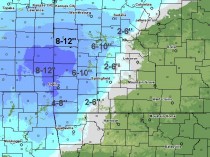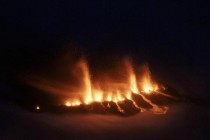An unusually late season snow hit the southern plains the last several days. After heavy snows fell in Wyoming and Colorado, heavy snow (8-12 inches) bands redeveloped in southeast Kansas, southwest Missouri and eastern Oklahoma (see map here).

Lighter amounts fell in north Texas but it places like Dallas the most so late in the season. Recall earlier in the winter, the earliest measurable snow on record fell in Houston and in February 12.5 inches fell in Dallas.
PUBLIC INFORMATION STATEMENT
NATIONAL WEATHER SERVICE FORT WORTH TX
1137 AM CDT SUN MAR 21 2010
...SPRING SNOW FOR DFW…
Dallas Fort Worth DFW airport recorded 1.2 inches of snow on March 20th. This breaks the previous daily record for March 20th of 0.4 inches set in 1970. An additional 0.1 of an inch officially fell on March 21st and the event total is 1.3 inches. The additional 1.3 inches brings the 2009-2010 winter total to 17.1 inches. This ranks second of all time and came 0.5 inches shy of tying the all-time record of 17.6 inches set in 1977 -1978.
This snow event was unseasonably late in the year. The last time an inch or more fell at DFW later than March 20th was when 2 inches fell on March 29th in 1937.
-------------------------
DALLAS/FORT WORTH - SNOWIEST SEASONS
1 17.6 1977-78
2 17.1 2009-10*
3 15.3 1963-64
4 13.5 1923-24
5 10.4 1976-77
6 9.5 1909-10
7 9.2 1916-17
8 8.8 1947-48
9 8.1 1937-38
10 7.3 1965-66
10 7.3 1941-42
See PDF.
------------------------
Volcano erupts in Iceland, hundreds evacuated
By Gudjonb Helgason and Paisley Dodds, AP
REYKJAVIK, Iceland - A volcano erupted near a glacier in southern Iceland, shooting ash and molten lava into the air and forcing the evacuation Sunday of hundreds of people from a nearby village.

There were no immediate reports of injuries or damage from the volcano but a state of emergency was declared in communities near the Eyjafjallajokull glacier and scientists feared the eruption could trigger a larger and potentially more dangerous eruption at the nearby Katla volcano.
Saturday’s eruption, which occurred just before midnight (2000 EDT, 8 p.m.), came weeks after a series of small earthquakes. Television footage showed lava flows along the fissure.
“This was a rather small and peaceful eruption but we are concerned that it could trigger an eruption at the nearby Katla volcano, a vicious volcano that could cause both local and global damage,” said Pall Einarsson, a geophysicist at the University of Iceland’s Institute of Earth Science.
Icecap Note: The eruption was mainly a low level event - mainly lava and ash below 5000 feet. Gases emitted may be reaching higher. The threat is what COULD come next. The volcano Katla is subglacial and has a reputation as one of the most dangerous volcanoes of Iceland. Its peak reaches 1493 m in height and the extension of the glacier Myrdalsjokull which lies over it reaches 595 sq km. The crater of the volcano has a diameter of 10 km and the volcano normally erupts every 40 - 80 years. The last eruption took place in 1918, meaning scientists monitor the volcano very carefully. Since 930, 16 eruptions have been documented. The Laki craters and the Eldgja are part of the same volcanic system, so it can be regarded as one of the most powerful in the world.
Authorities evacuated 450 people in the area 160 kilometers (100 miles) southeast of the capital, Reykjavik, said Vidir Reynisson of the Icelandic Civil Protection Department. Evacuation centers were set up near the village of Hella.
The most immediate threat was to livestock because of the caustic gases.
“We had to leave all our animals behind,” Elin Ragnarsdottir, a 47-year-old farmer, told RUV, Iceland’s national broadcaster from one of the evacuation centers. “We got a call and a text message ... and we just went.”
Iceland sits on a large volcanic hot spot in the mid-oceanic ridge. Volcanic eruptions are often triggered by seismic activity when the Earth’s plates move and when magma from deep underground pushes its way to the surface.
Scientists have been monitoring recent activity using seismometers and global positioning instruments,
“This event has had a long prelude in earthquake activity,” Einarsson told The Associated Press. “The volcano has been inflating since the beginning of the year, both rising and swelling. One of the possible scenarios we’re looking at is that this small eruption could bring about something bigger.”
Authorities initially feared the eruption occurred below the 100-square-mile (160 square-kilometer) glacier and could have triggered floods if the glacial ice melted. Scientists, however, concluded from an aerial survey Sunday that the eruption occurred near the glacier in an area where there was no ice.
“This is the best possible place for an eruption,” said Tumi Gudumundsson, a geologist at the University of Iceland.
There hasn’t been an eruption near the Eyjafjallajokull glacier since 1821.

The Icelandic Civil Aviation Administration ordered aircraft to stay 120 nautical miles away from the volcano area, essentially closing it off because visibility is low in some areas. Reykjavik appeared to be unaffected with clear visibility.
All domestic flights were canceled until further notice, the Icelandic National Broadcasting Service reported.
Three Icelandair flights from the U.S. - departing from Seattle, Boston and Orlando, Florida - bound for Keflavik airport in Reykjavik were turned back to Boston, leaving about 500 people waiting, the airline said.
Flights to Stockholm, London, Amsterdam and Frankfurt were scheduled to leave Sunday morning but a flight to Oslo was canceled and passengers were being rerouted. The airline expected further delays throughout Sunday.
First settled by Vikings in the 9th century, Iceland is known as the land of fire and ice because of its volcanos and glaciers.
In the mid 1780s, the Laki volcano erupted, prompting scores to die of famine when livestock and crops were destroyed. During the Middle Ages, Icelanders called the Hekla volcano the “Gateway to Hell,” believing that souls were dragged below. Hekla is Iceland’s most active volcano.
See report on how high latitude volcanoes affect climate with a look at Alaska, Iceland and Kamchatka here.




